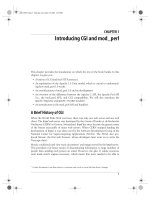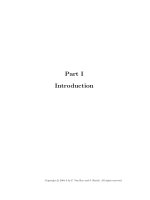Chapter 1: Computer Abstraction and Technology ppsx
Bạn đang xem bản rút gọn của tài liệu. Xem và tải ngay bản đầy đủ của tài liệu tại đây (1.69 MB, 50 trang )
BK
TP.HCM
2009
dce
KIẾN TRÚC MÁY TÍNH
CS2009
Khoa Khoa họcvàKỹ thuậtMáytính
BM Kỹ thuậtMáytính
Võ TấnPhương
/>2009
dce
©2009, CE Department
2
9/14/2009
Course Syllabus
• The Content
– Chapter1 (week1-2): Introduction to Computer Abstraction and
Technology
– Chapter2 (week3-5): Instructions – Language of the Computer
– Chapter3 (week6-7): Arithmetic for Computers
– Chapter4 (week10-12): The Processor
– Chapter5 (week13-14): Storage and Other IO topics
– Chapter6 (week15-16): Memory Systems
• References
– David A. Patterson and John L. Hennessy, Computer Organization &
Design – The Hardware/Software Interface, 4th Edition, Morgan
Kaufmann Publishers, 2008
– William Stallings, Computer Organization and Architecture –
Designing for Performance, 7th Edition, Pearson International Edition,
2006.
• Homepage:
• Grading Policy:
– Homework: 20%
– Midterm examination: 30%
– Final examination: 50%
2009
dce
©2009, CE Department
3
9/14/2009
Course Overview
• Principle and organization of digital
computers,
• Bus organization and memory design,
• Principle of computer’s instruction set and
programming in assembly language (some
popular processors are used such as
MIPS, Intel x86, ARM, …),
• Interface between the processor and
peripherals,
• Performance issues in computer
architecture.
2009
dce
Why study Computer Architecture
• To be a professional in any field of computing today,
you should not regard the computer as just a back
box that executes program by magic.
• You should understand a computer system’s
functional components, their characteristics, their
performance, and their interactions.
• You need to understand computer architecture in
order to build a program so that it runs efficiently on
a machine.
• When selecting a system to use, you should be able
to understand the tradeoff among various
components, such as CPU clock speed vs. memory
size.
©2009, CE Department
4
9/14/2009
2009
dce
Chapter 1
Adapted from Computer Organization and
Design, 4
th
Edition, Patterson & Hennessy, ©
2008
©2009, CE Department
5
9/14/2009
Computer Abstraction and
Technology
2009
dce
The Computer Revolution
• Progress in computer technology
– Underpinned by Moore’s Law
• Makes novel applications feasible
– Computers in automobiles
– Cell phones
– Human genome project
– World Wide Web
– Search Engines
• Computers are pervasive
9/14/2009
©2009, CE Department Chapter 1 — Computer Abstractions and Technology — 6
2009
dce
Classes of Computers
• Desktop computers
– General purpose, variety of software
– Subject to cost/performance tradeoff
• Server computers
– Network based
– High capacity, performance, reliability
– Range from small servers to building sized
• Embedded computers
– Hidden as components of systems
– Stringent power/performance/cost constraints
9/14/2009
©2009, CE Department Chapter 1 — Computer Abstractions and Technology — 7
2009
dce
The Processor Market
9/14/2009
©2009, CE Department Chapter 1 — Computer Abstractions and Technology — 8
2009
dce
What You Will Learn
• How programs are translated into the
machine language
– And how the hardware executes them
• The hardware/software interface
• What determines program performance
– And how it can be improved
• How hardware designers improve
performance
• What is parallel processing
9/14/2009
©2009, CE Department Chapter 1 — Computer Abstractions and Technology — 9
2009
dce
Understanding Performance
• Algorithm
– Determines number of operations executed
• Programming language, compiler, architecture
– Determine number of machine instructions executed
per operation
• Processor and memory system
– Determine how fast instructions are executed
• I/O system (including OS)
– Determines how fast I/O operations are executed
9/14/2009
©2009, CE Department Chapter 1 — Computer Abstractions and Technology — 10
2009
dce
Below Your Program
• Application software
– Written in high-level language
• System software
– Compiler: translates HLL code to
machine code
– Operating System: service code
• Handling input/output
• Managing memory and storage
• Scheduling tasks & sharing resources
• Hardware
– Processor, memory, I/O controllers
9/14/2009
©2009, CE Department Chapter 1 — Computer Abstractions and Technology — 11
2009
dce
Levels of Program Code
• High-level language
– Level of abstraction closer
to problem domain
– Provides for productivity
and portability
• Assembly language
– Textual representation of
instructions
• Hardware representation
– Binary digits (bits)
– Encoded instructions and
data
9/14/2009
©2009, CE Department Chapter 1 — Computer Abstractions and Technology — 12
2009
dce
Components of a Computer
• Same components for
all kinds of computer
– Desktop, server,
embedded
• Input/output includes
– User-interface devices
• Display, keyboard, mouse
– Storage devices
• Hard disk, CD/DVD, flash
– Network adapters
• For communicating with
other computers
The BIG Picture
9/14/2009
©2009, CE Department Chapter 1 — Computer Abstractions and Technology — 13
2009
dce
Anatomy of a Computer
Output
device
Input
device
Input
device
Network
cable
9/14/2009
©2009, CE Department Chapter 1 — Computer Abstractions and Technology — 14
2009
dce
Anatomy of a Mouse
• Optical mouse
– LED illuminates
desktop
– Small low-res camera
– Basic image processor
• Looks for x, y
movement
– Buttons & wheel
• Supersedes roller-ball
mechanical mouse
9/14/2009
©2009, CE Department Chapter 1 — Computer Abstractions and Technology — 15
2009
dce
Through the Looking Glass
• LCD screen: picture elements (pixels)
– Mirrors content of frame buffer memory
9/14/2009
©2009, CE Department Chapter 1 — Computer Abstractions and Technology — 16
2009
dce
Opening the Box
9/14/2009
©2009, CE Department Chapter 1 — Computer Abstractions and Technology — 17
2009
dce
Inside the Processor (CPU)
• Datapath: performs operations on data
• Control: sequences datapath, memory,
• Cache memory
– Small fast SRAM memory for immediate
access to data
9/14/2009
©2009, CE Department Chapter 1 — Computer Abstractions and Technology — 18
2009
dce
Inside the Processor
• AMD Barcelona: 4 processor cores
9/14/2009
©2009, CE Department Chapter 1 — Computer Abstractions and Technology — 19
2009
dce
Abstractions
• Abstraction helps us deal with complexity
– Hide lower-level detail
• Instruction set architecture (ISA)
– The hardware/software interface
• Application binary interface
– The ISA plus system software interface
• Implementation
– The details underlying and interface
The BIG Picture
9/14/2009
©2009, CE Department Chapter 1 — Computer Abstractions and Technology — 20
2009
dce
A Safe Place for Data
• Volatile main memory
– Loses instructions and data when power off
• Non-volatile secondary memory
– Magnetic disk
– Flash memory
– Optical disk (CDROM, DVD)
9/14/2009
©2009, CE Department Chapter 1 — Computer Abstractions and Technology — 21
2009
dce
Networks
• Communication and resource sharing
• Local area network (LAN): Ethernet
– Within a building
• Wide area network (WAN: the Internet
• Wireless network: WiFi, Bluetooth
9/14/2009
©2009, CE Department Chapter 1 — Computer Abstractions and Technology — 22
2009
dce
Technology Trends
• Electronics
technology
continues to evolve
– Increased capacity
and performance
– Reduced cost
Year Technology Relative performance/cost
1951 Vacuum tube 1
1965 Transistor 35
1975 Integrated circuit (IC) 900
1995 Very large scale IC (VLSI) 2,400,000
2005 Ultra large scale IC 6,200,000,000
DRAM capacity
9/14/2009
©2009, CE Department Chapter 1 — Computer Abstractions and Technology — 23
2009
dce
Defining Performance
• Which airplane has the best performance?
0 100 200 300 400 500
Douglas
DC-8-50
BAC/Sud
Concorde
Boeing 747
Boeing 777
Passenger Capacity
0 2000 4000 6000 8000 10000
Douglas DC-
8-50
BAC/Sud
Concorde
Boeing 747
Boeing 777
Cruising Range (miles)
0 500 1000 1500
Douglas
DC-8-50
BAC/Sud
Concorde
Boeing 747
Boeing 777
Cruising Speed (mph)
0 100000 200000 300000 400000
Douglas DC-
8-50
BAC/Sud
Concorde
Boeing 747
Boeing 777
Passengers x mph
9/14/2009
©2009, CE Department Chapter 1 — Computer Abstractions and Technology — 24
2009
dce
Response Time and Throughput
• Response time
– How long it takes to do a task
• Throughput
– Total work done per unit time
• e.g., tasks/transactions/… per hour
• How are response time and throughput affected
by
– Replacing the processor with a faster version?
– Adding more processors?
• We’ll focus on response time for now…
9/14/2009
©2009, CE Department Chapter 1 — Computer Abstractions and Technology — 25









